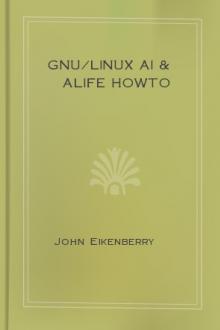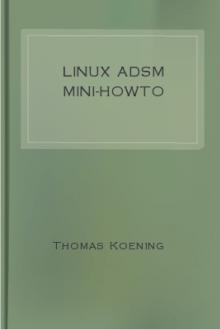GNU/Linux AI & Alife HOWTO, John Eikenberry [best books to read for self development TXT] 📗

- Author: John Eikenberry
- Performer: -
Book online «GNU/Linux AI & Alife HOWTO, John Eikenberry [best books to read for self development TXT] 📗». Author John Eikenberry
programming, bit string and real-valued genetic algorithms,
evolution strategy, coevolution, and evolutionary multi-objective optimization.
PGAPack
Parallel Genetic Algorithm Library
� Web site: www—
fp.mcs.anl.gov/CCST/research/reports_pre1998/comp_bio/stalk/pgapack.html
� FTP site: ftp.mcs.anl.gov/pub/pgapack/
PGAPack is a general-purpose, datastructure-neutral, parallel
genetic algorithm library. It is intended to provide most
capabilities desired in a genetic algorithm library, in an
integrated, seamless, and portable manner. Key features are in
PGAPack V1.0 include:
� Callable from Fortran or C.
� Runs on uniprocessors, parallel computers, and workstation
networks.
� Binary-, integer-, real-, and character-valued native data
types.
� Full extensibility to support custom operators and new data
types.
� Easy-to-use interface for novice and application users.
� Multiple levels of access for expert users.
� Parameterized population replacement.
� Multiple crossover, mutation, and selection operators.
� Easy integration of hill-climbing heuristics.
� Extensive debugging facilities.
� Large set of example problems.
� Detailed users guide.
PIPE
� Web site: www.idsia.ch/~rafal/research.html
� FTP site: ftp.idsia.ch/pub/rafal
Probabilistic Incremental Program Evolution (PIPE) is a novel
technique for automatic program synthesis. The software is
written in C. It …
� is easy to install (comes with an automatic installation
tool).
� is easy to use: setting up PIPE_V1.0 for different problems
requires a minimal amount of programming. User-written,
application-independent program parts can easily be reused.
� is efficient: PIPE_V1.0 has been tuned to speed up
performance.
� is portable: comes with source code (optimized for SunOS
5.5.1).
� is extensively documented(!) and contains three example
applications.
� supports statistical evaluations: it facilitates running
multiple experiments and collecting results in output files.
� includes testing tool for testing generalization of evolved
programs.
� supports floating point and integer arithmetic.
� has extensive output features.
� For lil-gp users: Problems set up for lil-gp 1.0 can be
easily ported to PIPE_v1.0. The testing tool can also be used
to process programs evolved by lil-gp 1.0.
pygene
� Web site: www.freenet.org.nz/python/pygene/
pygene is a simple and easily understandable library for genetic
algorithms and genetic programming in python. Includes examples
such as the travelling salesman problem.
pygp
� Web site: pygp.sourceforge.net/
Your basic genetic algorithm package for python.
Sugal
� Web site: www.trajan-software.demon.co.uk/sugal.htm
Sugal [soo-gall] is the SUnderland Genetic ALgorithm system.
The aim of Sugal is to support research and implementation in
Genetic Algorithms on a common software platform. As such, Sugal
supports a large number of variants of Genetic Algorithms, and
has extensive features to support customization and extension.
4.2. EC software kits/applications
These are various applications, software kits, etc. meant for research
in the field of evolutionary computing. Their ease of use will vary,
as they were designed to meet some particular research interest more
than as an easy to use commercial package.
ADATE
� Web site: www-ia.hiof.no/~rolando/adate_intro.html
ADATE (Automatic Design of Algorithms Through Evolution) is a
system for automatic programming i.e., inductive inference of
algorithms, which may be the best way to develop artificial and
general intelligence.
The ADATE system can automatically generate non-trivial and
novel algorithms. Algorithms are generated through large scale
combinatorial search that employs sophisticated program
transformations and heuristics. The ADATE system is particularly
good at synthesizing symbolic, functional programs and has
several unique qualities.
esep & xesep
� Web site(esep): www.iit.edu/~elrad/esep.html
� Web site(xesep): www.iit.edu/~elrad/xesep.html
This is a new scheduler, called Evolution Scheduler, based on
Genetic Algorithms and Evolutionary Programming. It lives with
original Linux priority scheduler.This means you don’t have to
reboot to change the scheduling policy. You may simply use the
manager program esep to switch between them at any time, and
esep itself is an all-in-one for scheduling status, commands,
and administration. We didn’t intend to remove the original
priority scheduler; instead, at least, esep provides you with
another choice to use a more intelligent scheduler, which
carries out natural competition in an easy and effective way.
Xesep is a graphical user interface to the esep (Evolution
Scheduling and Evolving Processes). It’s intended to show users
how to start, play, and feel the Evolution Scheduling and
Evolving Processes, including sub-programs to display system
status, evolving process status, queue status, and evolution
scheduling status periodically in as small as one mini-second.
Corewars
� Web site: corewars.sourceforge.net/
� SourceForge site: sourceforge.net/projects/corewars/
Corewars is a game which simulates a virtual machine with a
number of programs. Each program tries to crash the others. The
program that lasts the longest time wins. A number of sample
programs are provided and new programs can be written by the
player. Screenshots are available at the Corewars homepage.
Grany-3
� Web site: zarb.org/~gc/html/grany.html
Grany-3 is a full-featured cellular automaton simulator, made in
C++ with Gtk—, flex++/bison++, doxygen and gettext, useful to
granular media physicists.
JCASim
� Web site: www.jweimar.de/jcasim/
JCASim is a general-purpose system for simulating cellular
automata in Java. It includes a stand-alone application and an
applet for web presentations. The cellular automata can be
specified in Java, in CDL, or using an interactive dialogue. The
system supports many different lattice geometries (1-D, 2-D
square, hexagonal, triangular, 3-D), neighborhoods, boundary
conditions, and can display the cells using colors, text, or
icons.
JGProg
� Web site: jgprog.sourceforge.net
Genetic Programming (JGProg) is an open-source Java
implementation of a strongly-typed Genetic Programming
experimentation platform. Two example “worlds” are provided, in
which a population evolves and solves the problem.
5. Alife & Complex Systems
Alife takes yet another approach to exploring the mysteries of
intelligence. It has many aspects similar to EC and Connectionism,
but takes these ideas and gives them a metalevel twist. Alife
emphasizes the development of intelligence through emergent behavior
of complex adaptive systems. Alife stresses the social or group based
aspects of intelligence. It seeks to understand life and survival. By
studying the behaviors of groups of ‘beings’ Alife seeks to discover
the way intelligence or higher order activity emerges from seemingly
simple individuals. Cellular Automata and Conway’s Game of Life are
probably the most commonly known applications of this field. Complex
Systems (abbreviated CS) are very similar to alife in the way the are
approached, just more general in definition (ie. alife is a type of
complex system). Usually complex system software takes the form of a
simulator.
5.1. Alife & CS class/code libraries
These are libraries of code or classes for use in programming within
the artificial life field. They are not meant as stand alone
applications, but rather as tools for building your own applications.
AgentFarms
� Web site: www.agentfarms.net
Agent Farms is a system for modelling and simulation of complex,
multiagent based systems. The system can be used for:
� Creating models of multiagent systems
� Interactive and distributed simulation
� Observation and visualisation of the simulation
� Population modification and migration
Biome
� Web site: sourceforge.net/projects/biome/
Biome is a C++ library aimed at individual-based/agent-based
simulations. It is somewhat similar to Swarm, EcoSim or Simex
but tries to be more efficient and less monolithic without
compromising object-oriented design. Currently there is an
event based scheduling system, a C++ified Mersenne-Twister RNG,
several general analysis classes, some Qt-based GUI classes, a
very basic persistence/database framework (used also for
parameter storage) and many other small useful things.
CAGE
� Web site: www.alcyone.com/software/cage/
CAGE is a fairy generic and complete cellular automaton
simulation engine in Python. It supports both 1D and 2D
automata, a variety of prepackaged rules, and the concept of
“agents” which can move about independently on the map for
implementing agent behavior.
Integrating Modelling Toolkit
� Web site: sourceforge.net/projects/imt/
The Integrating Modelling Toolkit (IMT) is a generic,
comprehensive, and extensible set of abstractions allowing
definition and use of interoperable model components. Modellers
create an IMT “world” made of IMT “agents” that will perform
each a particular phase of a modelling task. The core set of
IMT agents can describe generic, modular, distributed model
components, either native to the IMT or integrating existing
simulation toolkits, specialized for tasks that range from
simple calculation of functions in an interpreted language to
spatially explicit simulation, model optimization, GIS analysis,
visualization and advanced statistical analysis. IMT agents are
designed to easily “glue” together in higher-level simulations
integrating different modelling paradigms and toolkits. The IMT
can be easily extended by users and developers through a
convenient plug-in mechanism
MAML
� Web site: www.maml.hu
The current version of MAML is basically an extension to
Objective-C (using the Swarm libraries). It consists of a couple
of remaining must be filled with pure swarm-code. A MAML-to-Swarm (named xmc) compiler is also being developed which
compiles the source code into a swarm application.
MASON
� Web site: cs.gmu.edu/~eclab/projects/mason/
MASON Stands for MultiAgent Simulator Of Neighborhoods… or
Networks… or something…
MASON is a fast discrete-event multiagent simulation library
core in Java, designed to be the foundation for large custom-purpose Java simulations, and also to provide more than enough
functionality for many lightweight simulation needs. MASON
contains both a model library and an optional suite of
visualization tools in 2D and 3D.
SimWorld
� Web site: www.nd.edu/~airolab/simworld/
SimWorld is a free artificial life simulation (based on the free
“” toolkit developed by Aaron Sloman), which provides
functionality for running different interacting agents and
objects in a simulated, continuous environment. The agents are
controlled by rules written in the powerful rule interpreter.
New behaviors of agents can be defined without any programming
knowledge.
Swarm
� Web site: www.swarm.org/wiki/Swarm_main_page
� FTP site: ftp.swarm.org/pub/swarm/
The swarm Alife simulation kit. Swarm is a simulation
environment which facilitates development and experimentation
with simulations involving a large number of agents behaving and
interacting within a dynamic environment. It consists of a
collection of classes and libraries written in Objective-C and
allows great flexibility in creating simulations and analyzing
their results. It comes with three demos and good
documentation.
5.2. Alife & CS software kits, applications, etc.
These are various applications, software kits, etc. meant for research
in the field of artificial life. Their ease of use will vary, as they
were designed to meet some particular research interest more than as
an easy to use commercial package.
Achilles
� Web site: achilles.sourceforge.net
Achilles is an evolution simulation based on Larry Yaeger’s
PolyWorld. It uses Hebbian neural networks, and an extremely
simplified physical model that allows virtual organisms to
interact freely in a simulated environment.
AntWars
� Web site: ant-wars.com
Ant Wars is a competition which pits clever programs against
each other to do battle and compete for food in virtual worlds.
Each contestant is a species of ant, which can visualize only
the world immediately around him and pheromones left by fellow
and enemy ants. Using this information, the ant brain (a simple
state machine) must guide the ant towards collecting food at his
home ant hill, while fending off or attacking enemies.
Clever use of pheromones and subtle behaviors can create large
scale tactics such as raiding, defense, harvesting, and scouting
when many ants cooperate.
Avida
� Web site: dllab.caltech.edu/avida/
The computer program avida is an auto-adaptive genetic system
designed primarily for use as a platform in Artificial Life
research. The avida system is based on concepts similar to those
employed by the tierra program, that is to say it is a
population of self-reproducing strings with a Turing-complete
genetic basis subjected to Poisson-random mutations. The
population adapts to the combination of an intrinsic fitness
landscape (self-reproduction) and an externally imposed
(extrinsic) fitness function provided by the researcher. By





Comments (0)